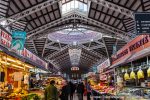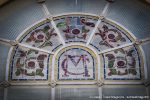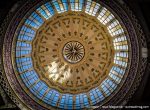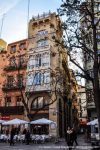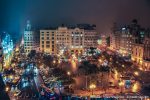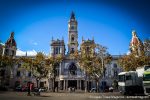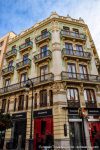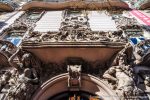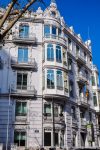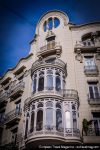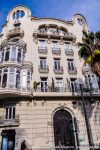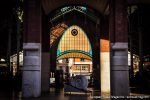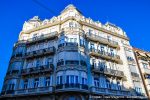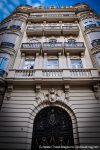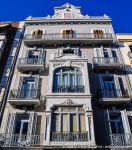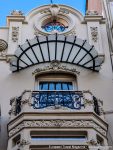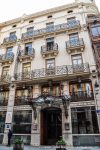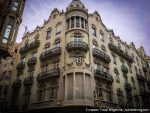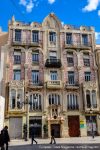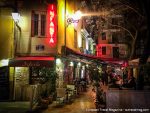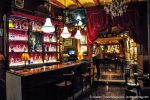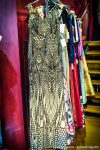Did you know that Valencia is one of the Spanish cities with the greatest collection of Art Nouveau architecture? Or Modernismo, as they call it in Spain? Me neither! Let’s discover these architectural gems together! On this self-guided tour of Valencia we’ll take you past some of the most beautiful buildings and historic architecture in Valencia. Here is the best Art Nouveau architecture in Valencia:
We’ve put together this 5 km. self paced walking tour, a.k.a. Art Nouveau Treasure Map, together for you to follow with Google Maps on your Smartphone. Our tour through the historic centre of Valencia and around Eixample quarter is a complete itinerary, that will take you past 43 beautiful Art Nouveau buildings. And when you’re done, there’s an Art Nouveau café waiting to serve you a delicious sangria!
We’ll start at the whopping Mercado Central, which construction began in 1914 but wasn’t complete until 1928. It blends the Art Nouveau style with the Gothic style of its neighbouring buildings, like the UNESCO World heritage declared Llotja de la Seda. The market is one of the biggest in Europe and features around 400 traders.
Continue to Casa Ordeig and further along the street, and pop your head into one of the few glass-covered galleries in Spain, Pasage Ripalda, before you enter the large main square; Plaza Ayuntamiento.
- Central Market of Valencia
- Central Market of Valencia
- Central Market of Valencia
- Central Market of Valencia
- Central Market of Valencia
- Central Market of Valencia
- Central Market of Valencia
- Casa Ordeig
- Casa Ordeig
- Pasaje Ripalda
- Pasaje Ripalda
- Pasaje Ripalda
Plaza Ayuntamiento is packed with stately Art Nouveau and Art Deco buildings. A walk around the block will take you past the imposing City Hall (free entrance and a museum!), Post Office (you MUST take a peek inside), the Suay building from 1910, Hotel Reina Victoria, Carrer de Correus no. 6 and Carrer de Roger de Llòria no. 3.
- Plaza Ayuntamiento
- Ayuntamiento de Valencia
- Ayuntamiento de Valencia
- Edificio de Correos
- Edificio de Correos
- Edificio de Correos
- Edificio de Correos
- Edificio Suay
- Edificio Suay
- Hotel Reina Victoria
- Hotel Reina Victoria
- Carrer de Correus 6
- Carrer de Roger de Llòria 3
- Carrer de Roger de Llòria 3
Continue south to the wonderful Estació del Nord. The exceptional train station was built between 1906 and 1917 in the so-called Vienna Secession style. It has hundreds of unique details and is a palace of the early 20th century progress and prosperity.
From here, we venture into the Eixample district, which literary means “extension”. All over Spain – and most famous in Barcelona – an Eixample district is often filled with Art Nouveau architecture, Walk past Carrer de Castelló no. 12 and enter the Gran Via boulevard, that is lined with grand architecture.
- Estació del Nord
- Estació del Nord
- Estació del Nord
- Estació del Nord
- Estació del Nord
- Estació del Nord
- Carrer de Castelló 12
- Carrer de Castelló 12
Carrer de Castelló no. 12 has charming wrought iron balustrades, that look like harps. Gran Via del Marqués del Túria no. 5 has elegant balconies and an amazing port. Casa Ortega at no. 9 from 1906 with its opulent sculptures, constitutes the one of the best examples of Valencian modernism. The architect Manuel Peris Ferrando (links to Spanish Wikipedia) was the first generation of Modernista architects in Valencia.
- Edificio Francisco Sancho at Carrer de Russafa at no. 29
- Edificio Francisco Sancho at Carrer de Russafa at no. 29
- Gran Via del Marqués del Túria no. 5
- Gran Via del Marqués del Túria no. 5
- Casa Ortega at Gran Via del Marqués del Túria no. 9
- Casa Ortega at Gran Via del Marqués del Túria no. 9
- Casa Ortega at Gran Via del Marqués del Túria no. 9
- Casa Ortega at Gran Via del Marqués del Túria no. 9
Turn left at the light grey Gran Via del Marqués del Túria no. 19 and then right along Carrer de Ciril Amorós, a street parallel to Gran Via and just as overflowing with Art Nouveau architecture. The corner building Casa Ferrer at no. 29 from 1907 was designed by Demetrio Ribes Marco (links to Spanish Wikipedia), who went on to do the Estació del Nord. As with the train station, this is an example of the Vienna Secession, that became popular in Spain after the International Congress of Architects in Madrid in 1904. If the doors are open, peek inside to admire the Modernismo interior.
The next eye-catching building is at no. 58. That means, if you can keep your eyes off Mercado Colon, but we’ll get to that! Continue along Carrer de Ciril Amorós past the white no. 64 and the cream no. 66. A right turn at the next street will take you back to Gran Via.
- Gran Via del Marqués del Túria 19
- Gran Via del Marqués del Túria 19
- Casa Ferrer at Carrer de Ciril Amorós 29
- Casa Ferrer at Carrer de Ciril Amorós 29
- Casa Ferrer at Carrer de Ciril Amorós 29
- Casa Ferrer at Carrer de Ciril Amorós 29
- Carrer de Ciril Amorós 58
- Carrer de Ciril Amorós 64
- Carrer de Ciril Amorós 66
Edificios Chapa cover the entire corner of this block on Gran Via and are no less than 8 plots with different shapes, that share a unitary façade. Three different architects built this half of one block between 1909 and 1913 and it’s the first Valencian attempt to give several different new buildings a homogenous exterior. Walk along Gran Via del Marqués del Túria and admire the decorum until you reach the end at the corner at no. 65, where you can have a look through the glass doors into the elegant foyer.
The last building on Gran Via is no. 59, after which you can take a look at Gran Via del Marqués del Túria no. 56 on the other side of the street, before you turn right and head back to Mercado Colon.
- Edificios Chapa
- Edificios Chapa
- Edificios Chapa
- Edificios Chapa, corner at no. 65
- Edificios Chapa, corner at no. 65
- Gran Via del Marques del Túria 59
- Gran Via del Marqués del Túria 59
- Gran Via del Marqués del Túria 56
The construction of Mercado Colon began in 1914 and finished a little more than two years later. As the neighbourhood started to grow, there was a demand for a covered market and Francisco Mora Berenguer (links to Spanish Wikipedia) designed this airy, open market. In contrast, the later Mercado Central was to be a closed market.
He had studied in Barcelona under Lluís Domènech i Montaner, which designed Palau de la Música Catalana and Hospital de Sant Pau and often attended the workshop of Art Nouveau genius Antoni Gaudí. It’s clear that he drew from the inspiration of those two great architects when he designed this elegant, palatial market. It was renovated at the turn of this century and has since 2003 been an architectural highlight of Valencia as well as a popular spot to wine, dine or just lounge around.
- Mercado Colon
- Mercado Colon
- Mercado Colon
- Mercado Colon
- Mercado Colon
- Mercado Colon
After a well-deserved replenishment in one of the many cafés, explore the many Art Nouveau buildings around the market, like Carrer de Jorge Juan no. 22, 20, 19 and 13, Carrer de Martínez Ferrando no. 5 and Carrer del Comte de Salvatierra no. 27 and 25.
- Carrer de Jorge Juan 22
- Carrer de Jorge Juan 20
- Carrer de Jorge Juan 13
- Carrer de Jorge Juan 19
- Carrer de Jorge Juan 19
- Carrer de Martínez Ferrando 5
- Carrer del Comte de Salvatierra 27
- Carrer del Comte de Salvatierra 25
- Carrer del Comte de Salvatierra 25
Continue along Carrer del Comte de Salvatierra past no. 19 with its elegant glass canopy covered balconies and no. 9 with the ornamented windows and robust, yet elegant wooden gate. Continue along Carrer de Sorní, past no. 14 with the vaulted windows and red brick sections until the corner of Carrer de Sorní and Carrer Colon. Here, the curious Edificio de los Dragones from 1901 blends Art Nouveau with Neo-Gothic and Moorish style, and its façade is decorated in the personal style of the architect José Manuel Cortina Pérez, a style that has been aptly been dubbed “fantastic medievalism”.
- Carrer del Comte de Salvatierra 19
- Carrer del Comte de Salvatierra 9
- Carrer del Comte de Salvatierra 9
- Carrer del Comte de Salvatierra 9
- Carrer de Sorní 14
- Edificio de los Dragones
- Edificio de los Dragones
Browse along the busy shopping street of Carrer Colon and turn left to cross the park of Plaça D’Alfons el Magnánimo into the elegant street of Carrer de la Pau, that’s just stuffed with Art Nouveau architecture, like the Vincci Palace Hotel with its elegant canopy of wrought iron and glass, the opposite Edificio Gomez I from 1903, that’s one of the first modernismo buildings in Valencia by Francisco Mora Berenguer and has a Gothic air to it, the Red Nest Hostel Valencia with ornamented windows and exceptional wooden door and Edificio Gomez II from 1905, also by Berenguer, which looks very much like Gaudí’s Casa Calvet in Barcelona, with bulging balconies and arched gables.
- Vincci Palace Hotel
- Vincci Palace Hotel
- Edificio Gómez I
- Red Nest Hostel Valencia
- Red Nest Hostel Valencia
- Edificio Gómez II
- Edificio Gómez II
At the end of Carrer de la Pau, on the corner of Carrer de Sant Vicent Màrtir and on the other side of this street as well, we have the eclectic Casa Sanchez de Leon, or Cuba Island Store, as it’s known. It has charming round windows and polychromatic plasterwork in brown and ochre colours together with dark blue glazed ceramics. Construction started in 1896, but wasn’t finished until 1909.
We finish the tour at the peculiar Casa del Punt de Gantxo. The ground floor is actually the Baroque chapel of San Valero and San Vicente from 1719, but the rest of the building is from 1906. The façade towards Plaça de l’Almoina is the most decorated, but go around the building and you will see, that the back of the house towards Plaça de l’Arquebisbe also speaks the same, naturalistic language. Sinuous plant form ledges, handrails and pilastres together with the red, glazed tiles makes this a very playful example of Valencian Art Nouveau.
- Cuba Island Store / Casa Sánchez de León
- Cuba Island Store / Casa Sánchez de León
- Cuba Island Store / Casa Sánchez de León
- Cuba Island Store / Casa Sánchez de León
- Casa del Punt de Gantxo
- Casa del Punt de Gantxo
If you want to finish off in true Art Nouveau style, stroll along Carrer dels Cavallers to Plaza del Tossal and head into the cosy Cafe Infanta. Here, among dark red curtains, curvy woodwork, crystal chandeliers and silent movies projected onto a screen, you can rest your feet and mind whilst sipping your favourite cocktail or their scrumptious sangria. Salud!
- Cafe Infanta
- Cafe Infanta
- Cafe Infanta
- Art Nouveau dress in Carrers dels Cavallers 40
- Art Nouveau dress in Carrers dels Cavallers 40
If you’re looking for a place to drink and dine with a view, you might want to read this article about Rooftop Restaurants in Valencia. If you’re an Art Nouveau fan and keen on going on Art Nouveau treasure hunts in other cities, check out our guide to Art Nouveau in Porto.
More information
Learn more

